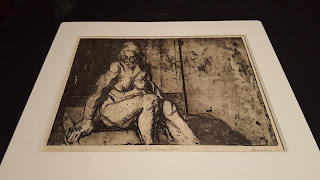"Drawing is an artist's most direct and intimate response to the world. Charcoal, graphite, and ink are each full of endless possibilities. I try to distil the essence of the subject and capture the life force of the moment. The challenge is to touch the subject with all the desire of a lover" - Maggi Hambling, 2016.
Maggi Hambling is better known for her sculptures. A Conversation with Oscar Wilde near Trafalgar Square must've been seen by millions of Londoners and tourists. Her Scallop that stands on Aldeburgh beach as a tribute to composer Benjamin Britten is equally iconic. Her paintings, too, mainly of waves and portraits, have earned her great acclaim.
The British Musuem's current exhibition Touch:Works on Paper takes a look at her drawings. Ascending a rather steep staircase into the room where they host Michelangelo's Epifania cartoon we're greeted by Hambling's charcoal Sebastian in a Hermes Scarf from 2004. Horsley, who died of a heroin and cocaine overdose aged 47 in 2010, was, nominally, an artist but he was more known for his extravagant dress sense, his dissolute life style, his use of prostitutes, and travelling to the Philippines to witness a crucifixion. His own one! Very much an old school Soho character. Hambling's portrait captures both this wantonness and what Stephen Fry, speaking at Horsley's funeral, called his 'essential sweetness'. Horsley's coffin was carried away accompanied by T.Rex's 20th Century Boy.
Hambling's artistic remit was fairly wide. She drew a stuffed rhino from an Ipswich museum, a bullfight in Barcelona, her dead mother, her dying father, Sir Georg Solti conducting, and skulls inspired by a trip to Mexico. The acrylic and collage Reclining Nude, Back View comes from 1965 when Hambling was studying at Camberwell School of Art. It's fifty years older than the newest work in this show proving that this, truly, is the fruit of a lifetime's labour and passion.
Max Wall and his Image (1981, above) veers a little close to sad clown territory but captures something of the charm of the odd looking man who used to scare the shit out of me when he came on telly when I was a kid. 1992's Amanda Leaning Over shows, in charcoal, the actress and former dancer Amanda Barrie. She went out with Billy Fury, appeared in Carry On films, and finally in Coronation Street as Alma where she had the indignity of marrying Mike Baldwin. It's nice that Hambling seems to make no distinction between the highbrow and the lowbrow. I think it's an approach more art, and more life, could benefit from.
Curator and art historian Sir Norman Rosenthal certainly belongs more to the former camp. The monotype (whatever that is) above from 1992 shows the former Exhibitions Secretary of the Royal Academy worked up from a few scratchy lines and marks. It's not a dissimilar technique to Lucian Freud and Hambling was using it as far back as 1963 as you can see from her Seated Female Nude etching from that year. It captures a realistic beauty and we get to feel like we're voyeurs looking in on a private moment. Or at least I do. Maybe that's my problem! I don't get out so much these days.
Perhaps I need to walk along the seafront a bit more. It certainly inspired Maggi Hambling. The way the high waters challenged the solidity of life. Wall of Water (2014, above) and Wave XI, an etching and aquatint from 2009, capture something of nature's seeming unpredictability, its beauty, and its awesome power. Not bad for a couple of square feet of black and white daubs.
My favourite of this section is Sea and Sky, Rottingdean, Morning, 1976. Hambling's use of ink here is wonderful. The bird floating in the sky in the upper reaches of the work really helps define the feeling of the great outdoors. It makes me want to get out walking again. Which I certainly will be doing soon.
Hambling could put her ink to many different ends. Below we can see Stephen (Fry) Falling Asleep from 1993 and, below that, the recently departed and much loved art historian, critic, and educator John Berger from 2000. Hambling visited Berger at his home in the French Alps and they became good friends. Her portrait manages to be both loving and intense. I think she really manages to convey Berger's fierce, yet friendly, intellect. He must've been honoured.
In some ways Berger reminds me of Beethoven in this portrait. A composer Maggi Hambling chose when she appeared on Desert Island Discs so perhaps it's no coincidence.
There are two outliers in the show. Henrietta Eating a Meringue (2001) is a plaster showing the sitter, and muse (that fucking word again, it's even written on her grave in Brompton Cemetery) of Freud and Bacon, Henrietta Moraes. It's far more abstract than anything else in the show.
Finally, as you leave, there's the ink and acrylic Edge (2015). A bold slash of colour that shows Hambling's interest in Chinese and Japanese calligraphy and, very obtusely, attempts to say something about global warming.
For a small, and free, show of what may be considered an artist's minor works it'd been astonishingly all encompassing and disparate. I enjoyed it a lot.
















No comments:
Post a Comment